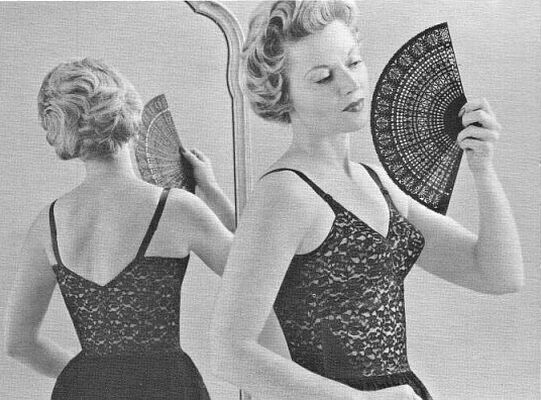Spencer in the USA in
1962
|
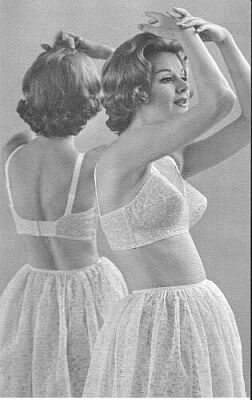 |
This is a fascinating era in the history of corsetry.
The post-Vietnam liberation, and the age of the 'Swinging Sixties' had
yet to begin, yet a change was evident in the underwear of the average
American woman. This was the pinnacle of foundation garment retail with
Warners, for example, selling six million girdles alone each year.
For decades, America and Europe had proceeded apace in the
development of their foundation garments, but for the first time, the
Americans stole a decade's march on their European sisters as the
panty-girdle became well and truly established. From now on, although
corsets and still girdles featured strongly, the panty-girdle would soon
dominate the mail-order brochures. In Britain, the panty-girdle only
really replaced the girdle at the end of the 1960's.
The bespoke houses of Spencer and Spirella (whose products appear
together in this catalogue) suffered here since their forte was
made-to-measure. To be honest, most panty-girdles do not need this
facility. |
 |
|


|
| As any corsetiere
will tell you, a brassiere is far harder to fit that any other
foundation. It is indeed, a feat of engineering, but Spencer
could offer you any shape of breast from pointed (coarsely
referred to as 'bullet'), through rounded to matronly, but
whatever the shape or age of the wearer, the breasts would be
lifted dramatically to the height dictated by the current
fashion. This was very much the male ideal of the female figure.
No woman actually wants to wear her bosom up by her shoulders,
nevertheless the matron on the right cuts a fine figure. Her
waist was not just reduced by the long-line brassiere either, a
firm corset was at work here. |
|
 |



The 130 bra (left)
but in a far more exotic material. The boned bodice that can cause acute
discomfort unless properly fitted and,
a new word in
the lexicon, 'torsolet', because 'Merry Widow' was
Warner's trademarked name, and no one had thought to call it a 'basque' yet.
A quirk of many foundation garment
catalogues is that when a brassiere is advertised, the model almost invariably
wears a slip or petticoat. Presumably the marketing department does not want the
'lower' to distract from the 'upper'. The converse does not apply since an
unsupported bosom looks somewhat unflattering and might even put the customer
off the girdle in question.
Panty-girdles
|
The panty-girdle is represented by four styles in the
catalogue, three of which are shown here. This does not appear to represent the
domination of the market to which I alluded above, however, this is more a
function of Spencer’s core business of bespoke foundations. The mail order
catalogues were becoming full of panty-girdles at this time. An interesting
observation is that the panty-girdle on the left has no suspenders. Was this a
summer garment where stockings would not be worn or was it an indication that
tights would soon dominate the market?
As an aside, it is interesting to follow the evolution of
the panty-girdle at this point. For decades, stockings were far shorter than
latterly was the case as skirts became worn higher and higher above the knee. As
the panty-girdle came into prominence, it started with rather short legs.
Suspenders fitted to the bottom rim matched the short stockings perfectly. The
panty-girdle started to evolve longer legs, providing the thigh control that so
many women required. For a while, the suspenders remained attached to the bottom
rim, however, this brought the suspender / stocking connection perilously close
to the casual observer’s eye. The solution was to move the suspenders up the
garment away from the rim. This occurred both inside and outside the garment.
Inside was less comfortable, but minimised the dreaded
suspender bump and this became more popular
than the external suspenders, where ‘flashes’ were used to conceal the bump.
The candid photograph of a Hollywood actress (right),
shows the extreme length of the hem-gartered girdle. From then on, the
suspenders would move inside the garment. This shot was neither for
publicity nor advertising, otherwise the stockings would have been
attached 'properly' i.e. without bunching the nylon. It's nice to know
that even Hollywood actresses are normal when not on display! |
 |
Girdles
What is interesting is that all the girdles here come from Spencer's 'Instant
Glamour' range. The more standard fare comes from Spirella that seems to imply a
slightly older style. Perhaps Mother wore the Spirella and daughter chose the
'Instant Glamour' if she wasn't already into panty-girdles.

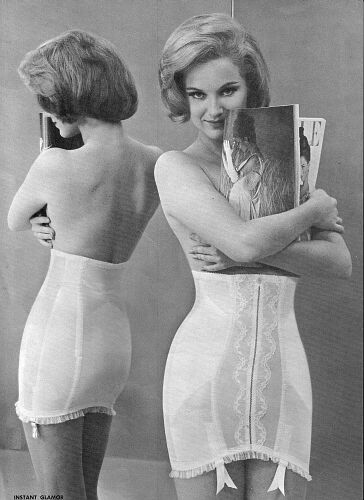
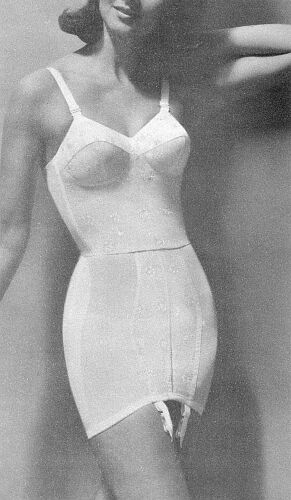
Spencer's 200, 210 and 275 from Spencer's 'Instant Glamour'
range.
The other fashion arm of Spencer was the Spencerette (left).
Note that despite the dramatically different materials, the cut is identical.
The Spirella 234 girdles (right), albeit in the Spencer brochure, have quite a
different cut that would appeal to Spirella's traditional clientele.
|
 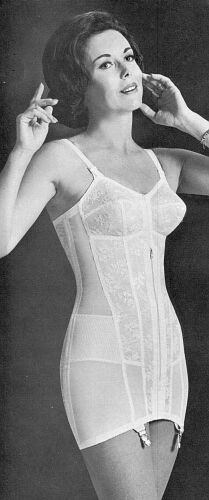

The 260 corselette (corselet in the USA) in exotic material
and white (left) and the famous Spenall.
|
Corsets
|
 |
Although Spencer made a perfectly serviceable corset
called the ‘posture corset’, their thrust was to the fashionable end of the
market and to the surgical end. The middle ground of plainer everyday corsets
and foundations was left to the Spirella range of their products. Thus it is
that in one catalogue, one sees elegant panty-girdles and torsolet from the
‘instant glamour’ range alongside Spencer’s old faithfuls the ‘belt’, the
lumbosacral and other surgical appliances. Spirella’s 305 and 335 make up the
missing link.

It is surprising to a British corsetiere, but Spencer marketed
the Spirella 305, possibly one of the best selling bespoke corsets of all time.
|
 |
|
 
Spencer's posture corset and 'belt' (above) and spinal,
spencerform and lumbosacral (below).
|
|
  
These garments remained essentially unchanged for five
decades. Only the models' hairstyles give away the date.
|









